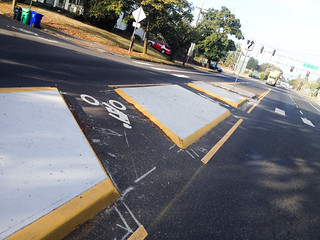
N Rosa Parks at Michigan.
(Photo by J. Maus/BikePortland)
A new traffic diverter at North Michigan Avenue and Rosa Parks Way seems to be successfully preventing north-south car traffic from spilling onto Michigan from Interstate 5, recent city bike counts show.
That was the city’s intent when it agreed last year to install the diverter in order to hold down traffic on the neighborhood greenway there.
“From I guess Holman to Rosa Parks it has gotten a lot better,” said Noah Brimhall, a Piedmont neighborhood resident and an advocate for the diverter, in an interview Tuesday.
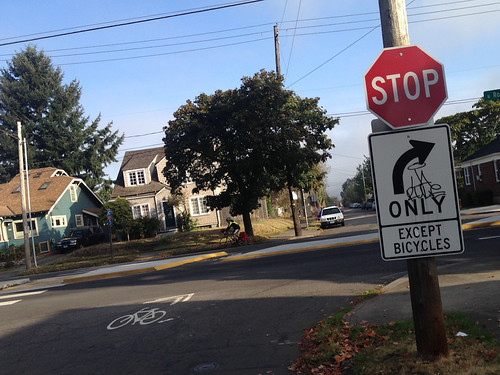
(Photo by J. Maus/BikePortland)
Since the diverter went in last fall, the city’s counts for auto traffic on Michigan south of Rosa Parks have fallen by an average of 25 percent from prior observations:
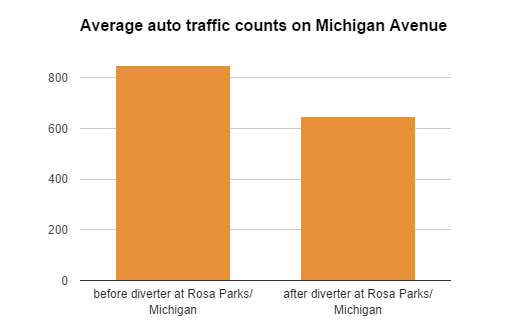
All eight traffic counts on Michigan showed a decline after the diverter went in. In the block immediately south of Rosa Parks, auto traffic dropped 45 percent.
Traffic even seemed to fall on nearby Mississippi Avenue — by 10 percent on average, suggesting that through traffic remained on the freeway or other routes rather than simply shifting one block further east.
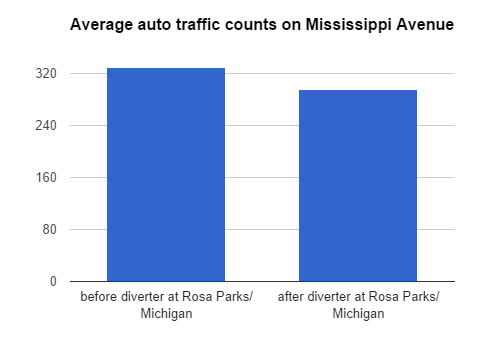
The drop in auto traffic, however, hasn’t yet led to a major surge in bike traffic on this neighborhood greenway, at least in absolute terms. The city’s north/south bike counts on Michigan increased from almost zero in 2011 to an average of 23 bikes in both directions during rush hour in 2014.
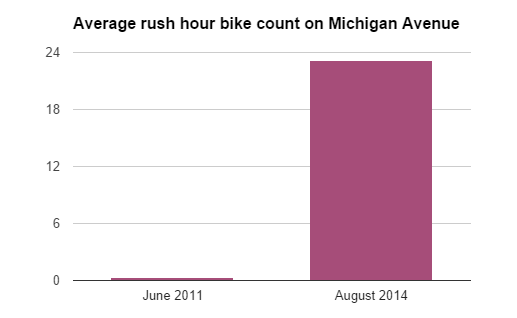
By contrast, the relatively comfortable east/west freeway crossings on Rosa Parks and Ainsworth drew bidirectional rush-hour bike counts in the 80s, an apparent sign of heavy demand for comfortable bikeways on major arterial streets.
Paul Anthony, chair of the Humboldt Neighborhood Association south of Rosa Parks, said his organization strongly supports biking improvements such as the Michigan Greenway “for obvious reasons” including reduced car traffic to Portland Community College and the economic benefits to retailers along Killingsworth and Mississippi.
“Frankly,” he said in an interview Tuesday, the rush-hour bike counts on Michigan were “disappointing.”
Advertisement
Brimhall, the Piedmont neighborhood advocate, said most people heading north and south by bike simply take the nearby wide bike lanes on Vancouver and Williams.
“A lot of people in this neighborhood and North Portland in general just tend to gravitate toward that street,” he said. “The reason I go over on Michigan is to get to my son’s school.”
He thinks the crossing at Killingsworth has poor lines of sight, and that poor pavement on Michigan south of Killingsworth makes the neighborhood greenway “less welcoming.”
Anthony agreed.
“Michigan’s surface is very, very poor,” he said. “I have ridden on the bikeway once and I’m not going to do it again until it’s resurfaced. it was actively painful.”
Greg Raisman, traffic safety specialist for the Portland Bureau of Transportation, wrote in an email that Michigan functions “more as a feeder route” in the bike network than as a collector, and that bike traffic is likely to grow on Michigan over time as it has on other neighborhood greenways.
“When Ankeny and Lincoln/Harrison were first implemented, it took some time for people to learn about the improvements and adjust their routes to take advantage of them,” he wrote. “Today, these routes carry more than 200 bicycle trips an hour in peak. … Also, if we are successful with securing additional transportation revenue, there are some things we could do to further improve Michigan that would likely attract riders.”
Update 2:52 pm: The charts in an earlier version of this post expressed average traffic counts for one direction only. The new charts express average counts in both directions for each location, which we feel is more intuitive. The trends are unchanged.

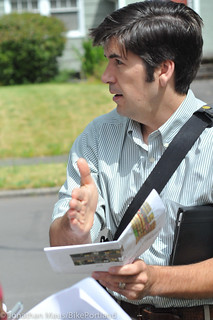



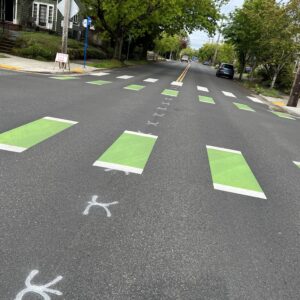
I use this crossing frequently, but didn’t before the diverter was installed so I can’t compare. It’s a little dicey (especially when transporting kids): often hard to see past the parked cars / morning sun glare on the left for oncoming traffic, and the cars from the I-5 offramp whip around that corner onto Rosa Parks pretty quick. Cars in both directions seem to feel the buzz of the nearby freeway, and drive a wee bit faster than I’d like them to.
It seems there are two key summary statements here:
1 “That’s an apparent sign of heavy demand for comfortable bikeways on major arterial streets.”
2 “Michigan functions “more as a feeder route” in the bike network than as a collector, and that bike traffic is likely to grow on Michigan over time as it has on other neighborhood greenways.”
The greenway also helps the neighborhood in general, regardless of bike traffic, because it reduces out of neighborhood drivers plying the local streets – often speeding – to bypass some other arterial they SHOULD be driving down. This in turn makes the neighborhoods my better for the people that live there, whether it’s Grandma G who just turned 95 or John the stay at home dad playing some b-ball outside on the neighborhood street hoop.
…thus, it might seem disappointing in one metric, but systemically it’s WAY better than it was!!
In addition to poor pavement South of Killingsworth, the crossing here is very sketchy during rush hour. Sightlines are poor, and you have to pull pretty far out into Killingsworth to see and be seen. Even though Michigan is more direct, If I’m riding solo, I use Albina, and if pulling the Beast in the trailer, I go further to Vancouver.
In my interview with Michael I mentioned this specifically as well. I think this may be at least as big of a factor as the poor pavement.
I’d agree with these statements as well. I have used Michigan a couple times to try it out, with the last time convincing me it wasn’t worth the trade-off of having comfort due to low volumes of cars between major streets in exchange for sketchy crossings and having to wait for a gap between cars at most of the major streets.
This is a case where skinny door-zone bike lanes along major thoroughfares with bike-friendly signal timing are just simply more efficient and preferred (for the record, I also sorta like bike lanes that don’t place the rider in the door zone).
However, I agree with Adron’s statement above that the improved roadway IS already much better for the neighborhood, which I fully support and understand the value of. That’s why diverters aren’t just good for bikes and bikes only, but for the livability of everyone that lives within the neighborhood.
Sorry I failed to capture that, Noah – I’ll add this in the post.
Michigan south of Killingsworth is an unfinished segment of the greenway. The street need a grind and overlay before speed bumps can be installed.
I don’t even KNOW any of the Bike Boulevards in North Portland. I feel like the well-established ones trip off the tongue (Salmon, Tillamook, Lincoln-Harrison), but the ones in North Portland I am CLUELESS about.
I think PBOT needs to step up and market the new bike routes more effectively. I’m a 15-year resident of Portland, been biking for ten of those years. And I haven’t got a CLUE what the North Portland bikeways are.
I feel like when the Going Street Bike Boulevard was created, there was a lot of buzz about it. I haven’t seen any comparable buzz for the North Portland bikeways.
You’re not going to get more bicyclists on these streets, without first letting them know they are there.
http://www.portlandoregon.gov/transportation/article/391056
But I am VERY happy to see the diverter has been so effective!
“sign of heavy demand for comfortable bikeways on major arterial streets.”
some examples of PBOT’s record on this:
hawthorne – fail.
mississipi -fail.
alberta – fail.
sandy – fail.
lower division – fail.
foster – bike lane detoured off major arterial to preserve parking.
28th – fail.
I would counter that Foster is only about a 4% fail, the rest of the project is a significant improvement over the current conditions. Also SE 52nd has seen a major improvement. And notice you left out upper Division.
Sure PBOT could be doing a lot more, but they are doing some things.
i agree.
Its still a fail if you want direct, connected routes.
A 4% fail isn’t that bad on its own, but they add up to an indirect route that is difficult to follow.
Lower division is coming along. With Clinton in sorry shape, division is ok alternative. I think cars have mostly given up on division.
“people would use Michigan Ave as a cut-through when I-5 was backed up”
Not disagreeing with this, but where would these people be coming from that they would be using Michigan to avoid I-5 when traffic was backed up?
Looking at the map, I can’t see where this traffic would be coming from. Or going to for that matter.
The Alberta – Killingsworth exit off I-5 is the source. Then they use the surface streets to go as far north as they can before getting on the freeway again to go over the river.
Exit 303 Swan Island/Killingsworth? That seems like an awful lot of turns (particularly left turns on busy streets) to be of much use since the exit dumps one onto Missouri.
Also they can only go to Rosa Parks. There is no other NB onramp to Intertate 5.
That’s what they’re doing. Most continue north on the frontage road to Killingsworth and go north on Missouri, Michigan or Mississippi. Localized diversion to deter such behavior would need strong support from local residents.
In order to get to Mississippi, often cars will get off at Alberta, and make a right onto Michigan. This prevents bikes from crossing Alberta because of heavy traffic, and creates dangerous, high-speed conditions for the route from Alberta south.
If a diverter were placed at Alberta preventing right turns, car traffic would be forced to take Albina in order to get to Mississippi. I have been hit once and nearly hit several times at this intersection. I have written to PBOT and have not received a reply. I am very grateful for the diverter on Rosa Parks. But one diverter does not a greenway make. Pease build one on Alberta!
These sentiments sound reasonable, but that’s not cut-through traffic avoiding I-5. That’s destination traffic.
Exactly. And destination traffic should be diverted to Albina (two blocks away), rather than using Michigan.
Do you mean left turns, since the freeway is west of Michigan?
Bikes making left turns onto Alberta heading north on Michigan.
I think hat is referring to cars making a right onto Michigan to get down to the Mississippi business district (parking south of Skidmore)
Michael, are you suggesting that Alberta should have a bike lane? While I agree that the I-5 crossings on Ainsworth and Rosa Parks are more comfortable than Alberta, might another reason for lower use be that Alberta turns into a neighborhood street east of Interstate and the others are a collector street all the way east to the Bluff? Regardless of the reason, do you think there really a “demand” for that? Are there really people out there who would be biking to work every day IF THERE WAS ONLY A BIKE LANE ON THE ALBERTA I-5 CROSSING!!!??
The data from Michigan Ave suggests that creating new bike routes does not always translate into more trips. So why would bike commuters use Michigan? Commuters coming from the east can take the Concord Ave greenway then Interstate, or the bike lane on Interstate and not even deal with crossing I-Commuters starting out west of Michigan can ride down to Vancouver Ave. Both of these options offer a direct shot to downtown where the Michigan greenway dead ends at Fremont where you choices are to ride Fremont over to Vancouver or ride down the steep drop to Interstate, which are the two routes you could have easily taken in the first place. A greenway on Michigan may be a nice amenity for the neighborhood and offer a convenient way for people to ride to Mississippi, but to my mind, it is redundant because it offers very little for the regular commuters heading to downtown.
Ted
Good point about Alberta, Ted. I was suggesting only that Alberta’s crossing is pretty uncomfortable, not the way to fix it, but you’re right that destinations west of the freeway are a big factor.
To my mind, the size of the bike counts on Rosa Parks and Ainsworth speak for themselves. I’ll remove the complicating reference to Alberta.
I am not sure I agree with that statement either since Ainsworth is not really a major arterial and does not have any bike improvements on it. It’s just a rediculously wide road when it crosses the highway. I am pretty sure the speed bumps that are there are for the benefit of Ockley Green. And the crossing on RP has had to be pretty heavily engineered in order to make navigating the I-5 on ramps somewhat comfortable for the many cyclists that were already using it.
Ted,
IMO, it is connections further south that are the biggest limit to the utility of Michigan. A connection via Mississippi to interstate could be made pretty comfortable, but Interstate seriously needs some attention. The extremely narrow pinch points under the Larrabee viaduct and Broadway bridge are really bad. Oversized motor vehicle lanes and high speeds make it worse. I would truly love to see PBOT stripe a 10.5 foot motorist lane all the way up and down interstate. The bike lane would be buffered by 7-8 feet in places, and nearly disappear in others. At least (more) motorists would stay in their lane and away from bikes, and the problem areas would become more visible to everyone!
I live on Albina and commute via Michigan every day. A couple of things I’ve noticed:
1. Just looking out my window, I see that a lot of people still bike on Albina/Mississippi. I don’t know if this is because people don’t know about Michigan, if Albina/Mississippi just seems more convenient, or if the bad pavement turns people off. Personally, I generally prefer the low traffic volume (and one less stoplight/stop sign!) on Michigan to jockeying with cars, trucks and buses on Albina, despite the lousy pavement – although I will take Albina if it seems like the traffic is lighter than normal.
2. There still seems to be a fair amount of car traffic in a few areas, at certain times of day: 1.) Between Fremont and Skidmore, both in terms of parking vultures (circling, circling) and drivers using it as a short cut to avoid the business district; 2.) Alberta to Skidmore, especially in the evening rush hour, southbound drivers using it to avoid the queue on Alberta; and 3.) around PCC, both related to PCC and drivers trying to avoid the queue on Killingsworth (evening rush hour).
Michigan is a fine Greenway, but teh connections I want to use are mostly pretty terrible. At the south end- Fremont east of Mississippi is pretty hostile to bikes with fast-driving cars and Mississippi to Interstate has horrible drivers and poor accommodation for bikes, esp. traveling north. Interstate Ave has well-documented deficiencies of skinny bike lanes, fast traffic, etc. Failing should be a greenway since it has the ped bridge over I-5 but it doesn’t function as one. Skidmore has been improve immensely recently west of Michigan, but to the east it is severely lacking (PBOT has a joke of a route to get from I-5 to 7th and Going- put bike facilities on SKidmore between Michigan and 7th!) North of that, Ainsworth is pretty good, but could use more traffic calming but north of Rosa Parks, the greenway just peters out. The Bryant route to the west is too convoluted. My point is that it makes sense to use Michigan as a feeder route, but PBOT needs to strengthen all of the connections to Michigan for it to be really functional
Agreed. Michigan and Skidmore west of Michigan are part of the N Going (Going to the River?) project. Michigan needs more connections to be of greater value, and a little more diversion. Maybe at the south end a route east to Vancouver-Williams, like along Cook-Ivy. PBOT has been looking at more of a trunk+branch model so that new greenways do more to create a grid.
I use Michigan between west-bound Rosa Parks and Skidmore frequently with my 10-year-old. The diverter allows us to get onto Michigan initially and most of the time, cars will stop and let us make that left turn through the diverters safely. This route should be marketed more to families because it’s the only way we can ride two abreast at a child’s speed without impeding faster bike commuters or cars. I talked up this route at a “Bike & Walk to School” event and found that many people are simply unaware of it. Also, the pavement issue south of Killingsworth is a huge issue, though easier to deal with if you’re going slow. It would be great if the city could at least repave a smooth strip in each direction like there is on some of the cobbled downtown streets.
Pavement south of Michigan isn’t great (lots of NE Going for that matter) but my biggest quibbles are where it meets Alberta and Killingsworth.
The limited pickup north of Killingsworth makes sense. No offense to Jonathan’s neighborhood, but Michigan dead-ends there, and Piedmont isn’t a destination. If you don’t live there and have to detour anyway, why bother?
Michigan gets you to Dekum 2 blocks east of the Bryant Street Bridge, which opens up a handful of fairly pleasant routes further into the NoPo peninsula. Eastbound on Dekum can get you onto Holman via Durham, which offers, besides an incredible bumpy ride, views of some seriously furry bunnies, an amazing looking treehouse, and a pretty easy ride to 42nd and further.
Err, not Dekum. I meant Bryant, of course.
However, PBOT is stalled on the Bryant/MLK crossing which was supposed to have a rapid flash beacon – but should probably also have a full median diverter.
So true. Vancouver’s older greenways took years for them to be discovered and used. Now that they’ve become “controversial”, it means that everyone who follows the mainstream media knows about them. The result has been the usage rising in a short time.
Looks like them trying to prevent the cycling revolution is backfiring.
Ted, I don’t really agree. I live by Peninsula Park, and Vancouver/Williams is too busy, and Concord too out of the way, for our commute-with-kid. I don’t know what we would have done without Michigan.
But I do think that the crossing at Killingsworth is not up to Neighborhood Greenway snuff. With cars streaming off the freeway on free rights, there are near to no gaps. In fact, I’d really like to see PBOT do a gap analysis during PM peak and tell me if they really think that the crossing conditions are OK as is. I sure don’t think so.
I also agree that the pavement quality is an issue…though it’s only a few blocks. My son had an official public comment about the pavement quality that we submitted to PBOT. Sadly, nobody ever responded. Take a listen: https://soundcloud.com/joshbzin/no-bumpy-roads
Oh yes, and I meant to say – the south end of N Michigan has a HUGE parking congestion problem on weekends and evenings. It may not be high speed, but it’s lots of people circling for parking and making erratic movements. Sort of like lower Ankeny, that degree of parking spillover from a hot corridor is not ideal for a greenway.
A gap study has been ordered.
Thank you. Awesome.
Are the counts per hour or per day?
Gap studies measure seconds of space between traffic, sorted into about 3 second groups, available to cross a street. The counts are done during the AM or PM peak traffic times – worst case scenario – and the number of gaps above the minimum needed to cross are compared to the standard. For Killingsworth, with curb extensions, the minimum gap needed is 26 seconds ((distance/3 ft per second)+3 sec perception/reaction time). Portland’s standard is 1 gap per minute (a pedestrian should not have to wait more than a minute for an adequate gap). 2012 counts at Kerby found 2.6 gaps per minute in the PM peak.
Portland uses the NCHRP 562 methodology to determine how to improve a greenway crossing, preferring to a level of service standard. Signing and marking the crossings would achieve the minimum level of service (50 crossings per hour; $1,200), while adding rapid flash beacons would achieve the preferred level of service (100 crossings per hour; +$24,000).
Can one be done for Alberta as well?
And the auto traffic counts in the post above are per day. (The bike counts are rush hours only.)
I’ve submitted a few safe@portlandoregon.gov maintenance requests for pothole repair on Michigan between Killingsworth and Webster. So far no luck.
Reviewing my email records, I see my original request was sent on Oct 3, 2011. Exactly 3 years ago.
I sent a follow-up email today, asking for an update…
If any of you want to see these potholes and fissures repaired within your lifetime, send an email to safe@portlandoregon.gov and with the subject line
“Pothole Request”
and the message
“Could you fill the potholes & fissures on N Michigan between Killingsworth and Webster? Luv, A. Bicyclist”
and maybe it will rise up in the queue.
FWIW,
Ted Buehler
I got a nice reply from my most recent request, they said they sent out a crew a few weeks after my first request in 2011.
And they said they’d send someone out to look at it again.
That doesn’t explain why the fissures didn’t get filled after the crew went out the first time, nor does it explain why the “hotline” was so cold for my subsequent requests over the last few years. But. With a little luck we’ll actually get the potholes fixed now.
If the holes are still there in a week, send in more requests to the hotline. If the holes are filled, send a thank-you note to the hotline and they’ll pass it on.
Ted Buehler